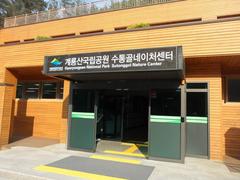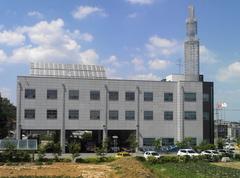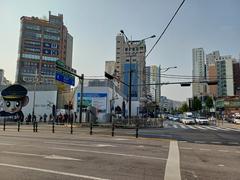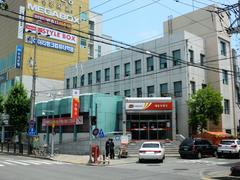Visiting Guide to Lee Ungno Museum Sejong
Date: 17/08/2024
Introduction
Nestled in the heart of Sejong City, South Korea, the Lee Ungno Museum stands as a testament to the enduring legacy of one of Korea’s most influential modern artists, Lee Ungno. Opened in 2007, the museum was established to celebrate and preserve the life and works of Lee Ungno, a pioneer who seamlessly blended Eastern and Western artistic traditions. The museum itself is an architectural marvel, designed by French architect Laurent Beaudouin, and has won several prestigious awards, including the Award of Excellence at the 2007 Korean Architecture Awards (Wikipedia). Visitors to the museum can expect a rich blend of history, art, and culture, with exhibitions that chronicle Lee Ungno’s artistic journey from his early bamboo paintings to his avant-garde paper collages and the emotionally charged ‘People’ series created during his exile in France (Korea Times). This guide provides essential information on visiting hours, ticket prices, guided tours, and tips for making the most out of your visit to this cultural gem. Whether you are an art enthusiast or a casual visitor, the Lee Ungno Museum offers a unique and enriching experience that bridges the artistic traditions of East and West.
Table of Contents
- Introduction
- History of the Lee Ungno Museum
- Visitor Information
- Significant Milestones and Exhibitions
- Integration with Digital Platforms
- Special Events and Commemorations
- Political Turmoil and Artistic Resilience
- Post-Imprisonment and Exile
- Legacy and Global Recognition
- Architectural and Artistic Fusion
- Visitor Experience
- FAQ
- Conclusion
History of the Lee Ungno Museum
Inception and Purpose
The Lee Ungno Museum, inaugurated in May 2007, was established to celebrate the life and career of Goam Lee Ungno (1904–1989), a pivotal figure in Korean modern and contemporary art. The museum aims to preserve and study resources related to Lee Ungno, ensuring that his artistic spirit is passed down to future generations (Google Arts & Culture).
Architectural Excellence
The museum’s building is an architectural marvel, designed by French architect Laurent Beaudouin. The design won the Award of Excellence at the 2007 Korean Architecture Awards and the Korea Architects Association Award. This collaboration resulted in a structure that embodies a fusion of Eastern and Western architectural elements, reflecting the artist’s own blending of cultural influences in his work (Wikipedia).
Visitor Information
Visiting Hours and Tickets
- Visiting Hours: The museum is open from 10:00 AM to 6:00 PM, Tuesday through Sunday. It is closed on Mondays and public holidays.
- Tickets: General admission is ₩2,000 for adults, ₩1,000 for students, and free for children under 6 and seniors over 65. Special exhibitions may have different pricing.
- Guided Tours: Available upon request, offering deeper insights into the life and works of Lee Ungno.
Travel Tips and Nearby Attractions
- Location: The museum is located in the heart of Daejeon’s cultural district, making it easily accessible by public transport and car.
- Nearby Attractions: Visitors can also explore other cultural sites such as the Daejeon Museum of Art and the Daejeon O-World theme park.
Significant Milestones and Exhibitions
Early Years and Notable Donations
In 2012, Seo Seung-wan donated a significant painting by Lee Ungno, titled Winds from the East, Winds from the West.
Educational and Cultural Programs
Lee Ungno’s influence extends beyond his artistic creations. In 1962, he founded the L’Académie de Peinture Orientale de Paris, the first educational program on Eastern painting in Europe. This institution has produced over 3,000 graduates of diverse nationalities, fostering active communication and exchange between Eastern and Western artistic traditions (Korea Times). Lee’s commitment to education was guided by his philosophy of bridging cultural gaps rather than merely propagating Eastern aesthetics.
Integration with Digital Platforms
The museum has embraced digital platforms to enhance the visitor experience. Virtual tours and online exhibitions are available, providing global access to Lee Ungno’s works and the museum’s educational content (Google Arts & Culture).
Special Events and Commemorations
120th Anniversary Exhibition
The museum’s recent exhibitions continue to highlight Lee Ungno’s significance in the global art scene. The 2024 exhibition, co-organized by the National Museum of Modern and Contemporary Art, Korea (MMCA), commemorates the 120th anniversary of Lee’s birth. This retrospective features nearly 40 works being showcased in Korea for the first time, including pieces from the collections of the Centre Pompidou and the Musée Cernuschi in Paris (Korea Times).
Political Turmoil and Artistic Resilience
The East Berlin Case
Lee Ungno’s life and work were deeply influenced by the political and social context of his time. His imprisonment during the East Berlin Affair, a period of intense ideological polarization in South Korea, had a profound impact on his artistic output. Even behind bars, Lee continued to create art, producing over 300 pieces using materials such as toilet paper, soy sauce, and rice paste (Korea Times). These works reflect his resilience and unwavering commitment to artistic expression despite adverse circumstances.
Artistic Production in Prison
The works produced during Lee’s imprisonment are particularly poignant, showcasing his ability to adapt and innovate under extreme conditions. These pieces are a testament to his resilience and dedication to his craft.
Post-Imprisonment and Exile
After his release, Lee continued to develop his artistic practice, blending traditional Korean techniques with contemporary Western styles. His time in France was especially productive, with significant contributions to the European art scene, including his involvement with the Art Informel movement.
Legacy and Global Recognition
International Exhibitions and Collections
Lee Ungno’s work is internationally recognized, with exhibitions held worldwide and his pieces included in major collections such as the Centre Pompidou and the Musée Cernuschi in Paris (Korea Times).
Educational Contributions
Lee’s commitment to education and cultural exchange has left a lasting legacy, influencing countless artists and fostering a deeper understanding of Eastern and Western artistic traditions.
Architectural and Artistic Fusion
The museum itself is a fusion of architectural and artistic elements, designed to reflect the blending of Eastern and Western influences in Lee Ungno’s work. This creates a harmonious space that enhances the visitor experience.
Visitor Experience
Visitors to the Lee Ungno Museum can expect a rich and immersive experience. The museum’s exhibitions are designed to take visitors on a chronological journey through Lee’s career, charting its major developments. From his early Collage series to the later Abstract Letter series, the museum provides a comprehensive view of Lee’s artistic evolution and his contributions to both Eastern and Western art.
To make the most of their visit, tourists are encouraged to explore the museum’s extensive collection and participate in guided tours that offer deeper insights into Lee’s life and work. The museum also hosts educational programs and workshops, providing visitors with hands-on experiences in traditional Korean art forms and modernist practices.
FAQ
- What are the opening hours of the Lee Ungno Museum? The museum is open from Tuesday to Sunday, with varying hours depending on the season.
- How much are tickets to the Lee Ungno Museum? Admission fees are reasonable, with discounts available for students, seniors, and groups.
- What is the address of the Lee Ungno Museum? The museum is located at 157 Dunsandaero, Seo-gu, Daejeon 35204, South Korea.
- Are there guided tours available at the Lee Ungno Museum? Yes, the museum offers guided tours that provide deeper insights into Lee Ungno’s life and work.
- What nearby attractions can be visited along with the Lee Ungno Museum? Nearby attractions include the Daejeon Museum of Art, Hanbat Arboretum, and the National Science Museum.
Conclusion
The Lee Ungno Museum is not just a repository of art; it is a vibrant cultural institution that bridges the gap between Eastern and Western artistic traditions. From its inception to its modern-day exhibitions, the museum has continually honored the legacy of Lee Ungno, offering visitors a comprehensive look into the life and works of this pioneering artist. With its diverse range of exhibitions, educational programs, and special events, the museum provides a rich and immersive experience for all visitors. The architectural brilliance of the museum, combined with its extensive collection of Lee Ungno’s works, makes it a must-visit destination for anyone interested in Korean modern art. As you plan your visit, be sure to check the official museum website for the latest updates on exhibitions and events, and consider participating in guided tours to gain deeper insights into Lee Ungno’s artistic journey. By visiting the Lee Ungno Museum, you are not only exploring the works of a great artist but also engaging with a cultural narrative that continues to inspire and educate future generations (Lee Ungno Museum) (Korea Times).
References
- Google Arts & Culture, n.d. Google Arts & Culture
- Wikipedia, n.d. Wikipedia
- Korea Times, 2024. Korea Times
- Arts de la Corée, n.d. Arts de la Corée
- Lee Ungno Museum, n.d. Lee Ungno Museum
- RealK, n.d. RealK



